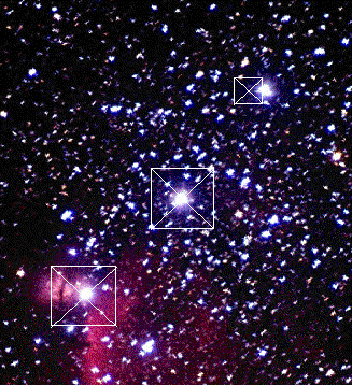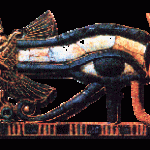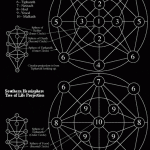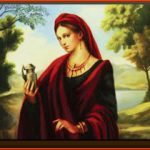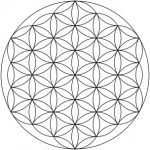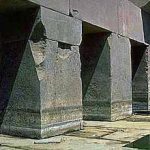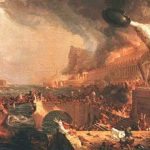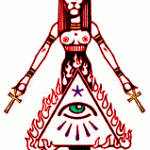by Daniel Roads
One
Just west of where the Nile begins to widen out into the fan-shaped delta, a rough limestone escarpment rises a few hundred feet and then flattens off into a wind swept plateau. An ancient civilization built a complex pattern of structures on the edge of the plateau, structures which have fascinated humanity throughout its history.
Consider the tale, first written down in the XVIIth Dynasty from a Middle Kingdom version of a IVth Dynasty original, of Prince Radjedef, the Djedi and King Khufu. The King and his four sons are relaxing at the palace telling stories of famous magicians. Radjedef tops them all by announcing that he knows of a living magician equal to those of the past. Khufu is interested and Radjedef tells him of the Djedi, or stable one, who is apparently ageless and knows many things, including “the shrines of the secret chambers of the enclosure of Tehuti.” Now Khufu is really interested, because the King “had spent much time in seeking for himself these secret chambers of the enclosure of Tehuti to fashion for himself their likeness for his horizon.” Khufu dispatches Radjedef to bring the Djedi back to the palace.
He returns with the Djedi, who quickly charms and awes the court with his magickal abilities. Then the King comes to the point: “Now, as for the rumor that you know the number of the shrines of the secret chamber of the enclosure of Tehuti…?” Djedi says that he does not, although he knows where that information can be found. “There is a box of flint in a chamber called the Revision of On: in that box.” The Djedi claims that he cannot recover this information, but the eldest of the triplets then in the womb of the wife of the high priest of “Re, Lord of Sakhbu,” will discover the information and found a new Dynasty.
Whatever we may think of the miraculous origins of the Vth Dynasty, this tale poses some interesting questions. Just what is the “enclosure of Tehuti?” And what are the “shrines of the secret chambers” whose likeness Khufu wants for his own “horizon?” Why is it that the information concerning these secrets could be found in a chamber called “Revision” in On, or Heliopolis as the Greeks called it a thousand years into its decline?
The so-called Inventory Stele of Khufu, found in the Isis Chapel near Khufu’s mortuary temple at Giza in the 1850’s, suggests that the “enclosure of Tehuti” is none other than the Great Pyramid complex itself. The stele clearly states that at least the Great Pyramid and the Sphinx were in existence at the time Khufu ascended to the throne. Peter Lemesurier, a pyramid scholar, has speculated that Khufu, which means simply (he) “protects us,” assumed the name of the traditional builder of the pyramid, Knum Khufu, or “Knum protects us,” to symbolize his possibly reincarnative connection with this semi-mythical builder. One of the earliest artifacts of Egyptian civilization, the Narmer palette, indicates that the pyramids predated the unification of Upper and Lower Egypt. A pyramid in a rectangular enclosure looms over the right shoulder of Narmer/Menes on the Lower Egypt side of the tablet like some relic from a forgotten age.
The Djedi story then presents us with the image of a King who doesn’t know the secret chambers of his own tomb, if we are to believe the Egyptologists. But the enclosure of Tehuti is clearly no tomb, and Khufu is sincerely interested in discovering its secrets. What these shrines of the secret chambers might be is suggested by the archaic title for the ancient Nome or precinct of On, Sakhbu. The literal translation of this word is “soul star place,” and the ancient Egyptians used it to describe the entire plateau at Giza.
The “soul star place,” which contains the enclosure of Tehuti and its secret chambers, is the Duat on earth through which the King travels as he makes his journey toward re-birth in Re’s Boat of a Million Years. Khufu wishes to know its secret so that his horizon, his transition, might truly result in immortality among the imperishable stars. This was no idle concern for Khufu. The Djedi story suggest that his failure to understand the mystery caused the failure of his Dynasty. It would be the Vth Dynasty Pharaohs who would bring forth or make public the secrets of the enclosure of Tehuti.
But the “soul star place” remains, and its inconceivably ancient monuments continue to haunt us with their mystery. But perhaps, just perhaps, the shrines of the secret chambers, like some time locked vault, have begun to open and we can glimpse an awe-filled universe of meaning and connection.
Two
The secret chambers began to open in 1989 with an article in the Oxford journal, Discussions in Egyptology. Engineer Robert Bauval argued that not only did the pyramids at Giza exhibit a grand unified pattern, but that pattern mirrored the stars in the constellation of Orion. In ancient Egypt, Orion was the “Place of Osiris,” suggesting a deep connection between the constellation and the myth of death and rebirth. Bauval’s idea made sense, (he would go on to co-author the bestsellers The Orion Mystery and The Message of the Sphinx) and further investigation has shown that the entire pyramid field, from Dashur to Abu Roash, mirrors the stars in the sky above it.
The plan of the Giza pyramids also exhibits an amazing degree of geometrical and mathematical coherence. For example, the three pyramids fit inside a rectangle formed from a vesica piscis, from which the generative roots (the square root of 2, 3 and 5) are derived. The vesica piscis also determines the angle of each face and the height of the floor of the King’s chamber. R.J. Cook demonstrated that a geometrical axial system linked the smaller pyramids with the center pyramid. He found that this system of linkages was based on the use of 60 degree and 26.5 degree angles.
Sixty degrees is the angle of an isosceles triangle; 26.5 degrees is the angle of the diagonal of a double square. The floor of the King’s Chamber is a double square and the ascending and descending passages are set at 26.5 degrees; this can hardly be accidental. The entire complex seems arranged to create a pointer indicating the helical rising of Orion/Osiris. Even more fascinating, a line drawn at 26.5 degrees north of east, the indicator point for the pre-dawn rise of Orion, runs from the second pyramid to Bethlehem in Palestine. Given the similarity between the dying god Osiris and the resurrected Christ, this alignment suggests an ancient stellar connection much too significant to be co-incidental.
A number of Giza researchers, including Max Toth, Rocky McCollum and William Buehler, have noticed that the arrangement of the three major pyramids produces a short section of a Golden Mean spiral. Extending this spiral on the ground leads to a small rise in the escarpment a few kilometers to the south-east of the pyramid complex. This area has received very little archeological attention since it covers a portion of the local village’s cemetery. The 1947 survey map notes the existence, near the center of the spiral, of an unidentified ruin of which nothing seems to have survived to the present. Without more research, including on-site inspection, the ground level Golden Mean spiral seems to be a dead end.
But, adds journalist, author and esoteric philosopher Jay Wiedner, what if we draw the Golden Mean spiral in the sky? If the pyramids are a model of the stars in Orion’s belt, then they should also describe a small section of the Golden Mean spiral. If we continue the line in the sky, following the yellow brick road of the Golden Mean, we arrive at the heart of the figure of Orion/Osiris.
Visually, this appears to be an empty region of space, but radio and x-ray astronomy reveal a seething area of collapsing stellar material below and to the left of the shoulder star, Bellatrix. Stars are being born in the heart of Orion. Indeed, the general area of Orion has more stellar formation occurring than anywhere else in our local galactic neighborhood.
The complex geometry of Giza, the Sakhbu or “soul star place,” apparently was designed to embed and encode certain “truths” about the star fields of Orion. Giza’s monuments function as a cosmic clock, ticking off the ages through cyclical stellar alignments while establishing galactic scale resonance with the regions of energetic star birth far off in Orion. This resonating clock reminds of us who we are and where we came from on a galactic scale. It holds our cosmic memory, that echo of self-awareness that allows us to overcome our monkey body programming.
Tron, the self-aware computer program in Disney’s film of the same name, claims his identity through memory: “I have seen the starships burning off the shoulder of Orion.”
Three
Our third question remains: If the enclosure of Tehuti is the pyramid complex itself and the shrines of the secret chambers are the stellar alignments and geometric resonance points on the Giza plateau, then how can this information be found in a flint box in a storeroom in Heliopolis?
Given that the “Book of Coming Forth unto the Light,” the core of the Pyramid Texts, appeared near the end of the Vth Dynasty, maybe SahuRe, the eldest of the royal triplets, did indeed find that flint box with the secret operating manual for the “soul star place.”
The Pyramid Texts, mankind’s oldest religious writings, were carved on the internal walls of one Vth Dynasty pyramid and four more from the VIth Dynasty. Frozen, like an ant in amber, these inscriptions record the definitive expression of an ancient star religion, whose beliefs included the translation of the dead king into a star in the constellation of Orion. Even the Victorian Egyptologists with their Christian and solar bias agreed that the Pyramid Texts had greater antiquity than the Vth Dynasty. Gaston Maspero, their original discoverer and translator, thought that “the greater part were originally written during the pre-historic period of Egypt.” That is, at least before about 3300 BC.
Professor R. T. Rundle Clark, who had a great respect for the Pyramid Texts, notes that “the rising of Orion in the southern sky after the time of its invisibility is the sign. . . Osiris has been transformed into a ‘living soul.’ ” (Remember, the ability to mark this moment is one of the major design factors involved in the overall plan of the monuments on Giza. This line, indicated by the 26.5 degree angle north of east, points to the summer solstice sunrise at the time of Orion’s return; it also runs to Bethlehem.) The Texts themselves are quite clear on this:
“Behold he has come as Orion, behold Osiris has come as Orion. . . O king, the sky conceives you with Orion, the dawn-light bears you with Orion. . . you will regularly ascend with Orion from the eastern regions of the sky, you will regularly descend with Orion in the western region of the sky.” (Pyramid Texts, line 820-2)
“O king, you are this Great Star, the Companion of Orion, who traverses the sky with Orion, who Navigates the (Duat) Netherworld with Osiris; you ascend from the east of the sky, being renewed in your due season, and rejuvenated in your due time. The sky has born you with Orion. . .” (Pyramid Texts, line 882-3)
A little further along in the same passage, we find an important clue: “I am a soul. . . I (am) a star of gold. . .” (Pyramid Texts, Line 886-9)
Thus the dead King, as an “Osiris,” evolved to inhabit a newly born stellar matrix in the constellation of Orion. The Duat, translated as Netherworld by most Egyptologists, actually appears to be the star birth Bardo field in the heart of Orion. There the newly immortal King must “Navigate the Duat” as a companion of Orion/Osiris. Significantly, the Osiris-king announces: “The sky is pregnant of wine (the dawn-light), Nuit has given birth to her daughter, the dawn-light, I raise myself indeed. . .” (Pyramid Texts, line 1082-3)
In several places in the Pyramid Texts, a curious statement is made: “The (dead) king’s sister is Sothis, (Sirius) his offspring is the Morning Star. . .” (Pyramid Texts, lines 357, 929, 935, 1707) It is easy to see Isis, Osiris’ sister/wife, as the star Sirius, which follows Orion in the sky. But to see Horus, Osiris’ offspring, as the Morning Star, Venus, takes a bit of understanding. Until we remember that Venus, rising against the zodiac of the ecliptic, creates a five pointed star through time. This symbol, a star made of five lines drawn from a common center toward the points in the zodiac of Venus’ rising, covers the ceiling of Unas’ pyramid where the earliest Pyramid Text is inscribed.
Horus, the son of Osiris, was the prototype of the earthly king; the Egyptian Pharaohs ruled in his name. As such, the symbol of Horus preserves the idea of transcendence and the possibility of stellar evolution. Again, the Pyramid Texts give a flavor of this: “. . .and Har-Sopd has come forth from you as Horus who is in Sothis (Isis). . . and he protects you in his name of Horus, the son who protects the father. . .” (Pyramid Texts, lines 632-3) Har-Sopd, or Horus who is the morning star, is depicted as a hawk-headed human with a Nuit star in a circle above his head.
If the Pyramid Texts are truly the operating manual for the monuments on Giza and their evolutionary resonance with the star fields of Orion, then they deserve much more study than they have received in the century or so since their discovery. Others, primarily Robert Bauval in The Orion Mystery, have drawn attention to these clues, but Egyptologists and archeologists have been slow to respond. No attempt has been made to examine other texts of comparable antiquity, such as the Builder Texts of Edfu and Dendera, for more clues. It is as if this tantalizing evidence of man’s early fascination with this vibrantly creative area of stellar birth leads to a dead end.
Perhaps for the academics, with reputations to make and preserve, it does. But for the group of mystics, scientists and esoteric philosophers I call the “Post-Modern Alchemists,” these clues provide startling evidence of ancient Egypt’s knowledge of the equivalent of a spiritual unified field theory. For them, the monuments on Giza are reminders of humanity’s galactic destiny.
Four
Let’s start with the clue about gold. “. . .I am a soul. . . I (am) a star of gold. . .” Osiris/Pharaoh announces. Before we dismiss this as mere poetry, remember that the Egyptian hieroglyphic language was capable of a dense structure of meaning. The “soul,” sa, has a precise meaning. It is the wave nature, the flow of the breath, of the spirit, the khu. The Hebrew word “ruach,” breath or spirit, preserves this meaning. In Genesis, we are told that God’s breath, His “ruach,” moved across the waters of chaos to begin the process of creation. The sages of On would have agreed, saying that Re put forth his sa as he rose from the waters of Nun.
Therefore, the king is declaring that he has entered the state of being called “soul,” a state where the flow of spirit is self-sustaining, self-referencing and self-aware. To be a soul is to have the possibility of immortality.
He reinforces this by declaring that he has become “a star of gold.” This also has a very precise meaning. One of the deepest held secrets of the Egyptian mysteries was how to rearrange the Nuit star, five lines pointing out from a common center, into an interlocked pentagram, the same five lines crossing around the common center to create an infinite nest of Phi ratios. To the Egyptian sages, this symbolized the embedding of cosmic evolution, the Horus current, into biological evolution.
And indeed, this pentagonal array is a constant in nature, appearing in everything from the petals on a flower to the bipedal symmetry of the human form. The Pythagoreans claimed that the pentagram was the perfect symbol of humanity, and that its extension into space, the Gnostic “light in extension,” the dodecahedron, was the ultimate symbol of spirit.
Just as the pentagram is a nest of phi ratio recursion, gold, by its atomic geometry, is the most fractally recursive element. The outer d/f electron sub-shells exhibit a 5/7 symmetry pairing, which gives gold the shape of the perfect dodeca-icosa fractal. The dodecahedron, the Pythagorean symbol of spirit, nests with the icosahedron, the symbol for water, to create a polygon that models the fractally attractive gravity well of our planetary jewel.
The alchemical process of making gold soluble in blood, the white powder Elixir of Immortality of the medieval alchemists, has been described at length by another post-modern alchemist, David Hudson.
Basically, ionized gold particles are subjected to a powerful and recursively shaped capacitive charge. The gold particles then do a pop-corn-like inside-out maneuver in their electron geometry. David Hudson calls this new form of gold “Ormes,” and suggests that it’s now soluble in the blood.
So the newly dead king’s statement can now be read as: “I am a self-sustaining, self-aware being, whose fractality is as infinite as the perfect shape of gold.” Suddenly, we are on a different level of understanding. With a flash, we see that the Egyptians were not just superstitious priests worshipping the sky out of ignorance, they were spiritual scientists with deep insight into the nature of reality and the physics of immortality. This insight seems to have come from the original creators of the Giza complex, those ancient sages who wrote down the secret texts and stored them in that flint box in Heliopolis.
Whether we consider these ancient sages as part of the lost prehistory of the human race or as visitors from another star system, their interest in gold mining and processing is demonstrated by the ruins and traces they left behind. Z. Sitchin, in his extensive revisioning of the Babylonian myths, has suggested that these alien visitors were mining gold to help repair a damaged atmosphere on their home planet. The fractal quality of gold would help increase the gravity of a planet and therefore help hold an atmosphere, but even ionized throughout the planet’s surface, it hard to see how even tons of gold would help. Yet, the ancient civilization, as shown by Graham Hancock in Fingerprints of the Gods, was certainly deeply concerned with mining and processing gold.
If the use of alchemical gold, (alchemy, remember, comes from Al Khem, the black land of Egypt) as a technological way to attain immortality suggests that embedding recursion into the blood, into the DNA, is the key, then there must be non-technological ways to produce the same effect. The Pharaoh did not become a soul by eating alchemical gold alone, he underwent another, internal, process to become a star of gold, a soul inhabiting a stellar matrix in the heart of Orion.
This internal process is based on embedding fractality in the DNA by the realization of infinite compassion. Literally, the oldest trick in the book.
Work by Lee Sanella and Isaac Bentov has shown that the onset of neural superconductivity, the tantric kundalini, is mediated by the sonic entrainment of the heart’s rhythm. A recent article, December, ’96, by Dr. Irving Dardik in Cycles magazine entitled “Heart Waves as Fractality,” confirms that fractal immune identity is a possible solution to chronic illness. Perfect fractality, perfect coherence and self-awareness produces perfect immunity, or near immortality of the body.
By meditating on compassion, feeling the feelings of all beings, DNA is braided into more complex and coherent patterns. These complex patterns can then contain the superconductive neural charge of kundalini onset and use this higher charge energy flow to braid a new being, the state of inhabiting a soul. This soul charge can then be used to open the magnetic wormhole to the star fields in Orion. Or, it can be used to create a diamond imperishable body for use as a teaching vehicle down here on earth.
From the Tibetan Buddhist tradition comes many examples of the latter use this implosive soul force. Padmasambhava, the tantric master who brought Buddhism to Tibet, is said to have attained his diamond body in the Asura Cave in Nepal after three years of tantric meditations. Something happened in that cave; the whole hillside is still pervaded with an astral intensity strong enough to grow a Tara image out of solid rock. Padmasambhava himself demonstrated the power of this transformation by melting the rock of the cave wall and pressing his hand into it like Clark Gable in wet cement on Hollywood Boulevard.
The Pharaoh then, as he began his journey to the star fields, should be seen as a kind of Boddhisatva, an enlightened being making a leap of evolution. The Pharaoh would, in theory, have completed the tantric-type compassion realization and then perhaps used a trace of alchemical gold to crystallize the process. Done properly, this would result in a compassionate, enlightened being capable of compassionately inhabiting a newly born star.
Carried to its end, the implications of this belief system suggests that our own star, the sun, is also inhabited by a vast compassionate and enlightened being. From this perspective, it is easy to understand the solar influence on Egyptian religion. Even Akhnaton’s insistence on worshipping the sun’s physical body, the Aton, as the only source of divinity makes sense as a way of establishing and strengthening a direct communication with that vast compassionate being whose star body is our sun.
Five
The monuments of the “soul star place” and their hieroglyphic operating manual, the Pyramid Texts, offer solid evidence of an advanced civilization far back in prehistory who understood both the stellar mechanics of our local galactic neighborhood and the psycho-dynamics of neural superconductivity. This alone should make us sit up and take notice. That it does not may have consequences far beyond our comprehension.
What happened to the advanced civilization that designed and built these monuments? Was it destroyed in some cosmic catastrophe predicted by its own cosmic clock? Is that catastrophe point approaching critical once again?
Such distant cultural groups as the Mayan and the Tibetan point to a date around 2012 as the crisis point. Terrence McKenna, in his “Time Wave Zero” computer program, which uses the permutation pattern found in the primal arrangement of the I Ching’s trigrams, predicts that novelty, or lack of continuity in ideas, will also reach infinite around December of 2012.
A clue to the dynamics of this cosmic crisis can be found in the work of Nick Fiorenza on what he calls the “Erection of the Holy Cross.” From our location in space, orbiting the sun, the center of the galaxy lies in the direction of the zodiacal sign Sagittarius. This unmoving axis locates us in space in relation to the center of the galaxy. The plane of our solar system is tilted 60 degrees from the galactic plane. The sun’s orbit around a center point near Alcyone in the Pleiades and the earth’s wobbling precession around the sun create another moving axis marked by the zodiacal sign of the spring and autumn equinoxes. As we approach a spring equinox that falls at the beginning of the sign of Aquarius, our two axis, galactic and local, approach a 90 degree angle.
When this happens, the informational and energetic inertia of the entire galaxy will implode in our local systems’ backyard. This cyclical implosion of galactic energy may have caused the planetary disaster that destroyed the builders of Giza. Graham Hancock, in Fingerprints of the Gods, notes the powerful geological evidence for some kind of catastrophe around 11,000 BC. Curiously enough, this was the last time the “Holy Cross” alignment swept through our galactic neighborhood.
Perhaps this cosmic event is meant to be a harvesting mechanism for biologics who have learned to inhabit “souls” through the realization of compassion. If that is the case, then learning to weave your Bardo body into nicely fractal flows of self-awareness as infinite compassion may just become the ultimate survival skill.
The geometry of Giza’s monuments and their resonance with the star fields of Orion teaches us that human evolution has a cosmic, stellar component. The pyramid complex holds our contiguous memory through the implosion of galactic catastrophe, and offers us hope for our own evolution. The ancient star religion believed that sentience was evolving toward ever greater levels of compassionate awareness as a living stellar matrix, coalescing and nurturing the planetary jewels in hopes of nourishing life, which would in turn evolve toward stellar sentience.
As Nuit declared in the first section of the Book of the Law: “Every man and every women is a star.”
More Articles from Sangraal.com:
Submit your review | |

